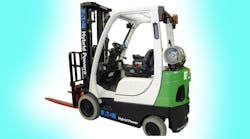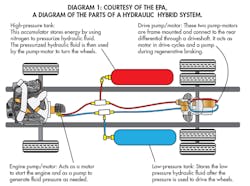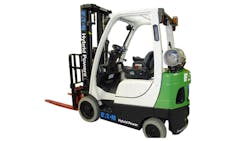The Ford Escape , Honda Insight, and Toyota Prius are just a few electric hybrid cars on the market. Although these cars are popular in the consumer market, there are limitations to electric hybrid cars when considering scalability. An alternative to the electric hybrid drive is the hydraulic hybrid drive. Hydraulic systems can store and discharge energy more efficiently than electric batteries. Vehicles that require a lot of power are finding hydraulic hybrid drives to be more efficient.
This file type includes high resolution graphics and schematics when applicable.
First, Some History…
The U. S. Environmental Protection Agency (EPA) has teamed up with such companies as Eaton, Parker Hannifin, Ford, and Chrysler to expand the hydraulic drive field. Back in 2004, the EPA announced that it developed a clean diesel combustion technology for the Ford Expedition, which incorporated an engine design that is simultaneously clean, efficient, and cost-effective. Now, using this concept in conjunction with a full hydraulic drive, this engine is projected to improve the fuel economy of this vehicle by 85% (percentage is higher for city driving).
The RunWise, an advanced series hydraulic hybrid drive system developed in 2005 by Parker Hannifin, has also shown significant results. Angelo Caponi, of Parker’s Hybrid Drive Systems Div., says the company launched 11 pre-production vehicles in three municipalities in South Florida in 2010. Over the past few years, the RunWise business has continued to grow, with more than 30 municipalities and private refuse haulers using the technology. (For more on this, see "Ohio Town Welcomes First Hydraulic Hybrid Garbage Trucks.")
More than 100 trucks in service employ the RunWise technology, reducing fuel consumption by up to 50%. In addition to the refuse vehicle market, the Parker’s Hybrid Drive Systems Div. has expanded into the parcel delivery market, with 48 trucks in use by UPS and Federal Express. The company expects growth to continue as it expands into the broader delivery and urban transportation market.
Hydraulic hybrids are also conserving energy in forklift trucks. Eaton Hydraulics has developed a hydraulic hybrid lift truck that demonstrated up to 35% fuel savings when compared to a baseline vehicle. This system also starts the vehicle’s engine, replacing the function of traditional electric starters. These innovations add up to lower maintenance costs.
Chrysler Group LLC and the EPA announced a partnership in January 2011 to determine the possibility of adapting a hydraulic hybrid system for large passenger cars and light trucks. Working together, both parties hope to reduce the size and complexity of the hybrid system. The research project will focus on adapting the hydraulic hybrid system to a Chrysler Town & Country minivan.
The Outlook from the IFPS
Through multifaceted work in education, training, and certification, the International Fluid Power Society strengthens and advances professional careers in the fluid power workforce. It is committed to facilitating and promoting the advancement of technology and professionalism of the fluid. The organization asserts that it is expanding knowledge in fluid power that will help reach the federal regulation to improve fuel economy by 10% by 2018.
Certification — In addition to mobile and industrial certifications for mechanics, technicians, and specialists, the newest IFPS certification — Electronic Controls Specialist — is in its final review and will be re-released in the first quarter of 2015. This certification is designed to review and test understanding, specification, and application of the full breadth of electronics used in the fluid power industry from simple sensors and limits to HMIs, controllers, and networks. It includes a brief review of applicable pneumatic and hydraulic principles, as well as in-depth examples of the electronics for both mobile and industrial fluid power equipment. The Electronic Controls Specialist certification requires a three-hour written test. This certification will be followed by the development of Mobile Electronic Controls and Industrial Electronic Controls certifications.
Several certifications are available from the IFPS. A self-assessment exam on its website can help users determine which are most suitable for them. Visit IFPS for details.
Education — The IFPS has a plethora of training initiatives ranging from basic to advanced and from online to in-person classes. Our newest collaboration is with the Safety Authority of Canada and offers international online Hydraulic Safety Awareness Online Training courses. Courses provide an awareness of hydraulic hazards in the workplace, in-depth reviews of potential exposures to injury from hydraulic systems, and ways to reduce risk and eliminate hazards for workers, equipment, companies, and the environment.
Shrinking and Simplifying
Advances for hydraulic hybrids are focused on expanding this technology for smaller vehicles. For Parker’s RunWise system, Caponi said growth is expected in medium-duty applications, such as city transit buses, smaller parcel vehicles, and food delivery vehicles. The medium-duty vehicle market is a customer base that has yet to be fully tapped, and new hydraulic transmission technology will help these vehicles achieve the fuel and cost savings desired for the urban customer.
Parker has a new medium-duty hydraulic transmission using the same proven, cost-saving technology as the RunWise advanced series hydraulic hybrid drive system, but in a smaller, lighter package. Both the transmission and system capture more than 71% of a vehicle’s otherwise lost braking energy to increase brake durability up to eight times longer than conventional trucks.
Chrysler is trying to use this technology in its non-commercial vehicles, such as the previously mentioned Chrysler Town & Country. The EPA has also modified Ford’s F-550 pickup and an Expedition SUV with similar systems.
Keys to Success
Modularization, packaging, and scalability are key components to Lightning Hybrids’ system, which is now available on more than 25 platforms around the world, supporting new and retrofit trucks and buses. By using many standard hydraulic components, Lightning says installation could be done in one day. Tim Reeser, president and co-founder of the company, said an increase in volume has reduced its cost by half over the last six months and he expects another decrease of 20% in the next nine months. As these costs are driven lower, Lightning Hybrids expects to continue expanding its platform offerings with new refuse truck applications for Asia and rear-engine bus applications for Europe and the U.S.
Size and complexity are a challenge, but not the only concerns. Other issues arise when considering the high pressures at which these systems operate. The Chrysler Town & Country’s system produces power with engine power driving a hydraulic pump that charges a high-pressure accumulator up to 5,000 psi. Trying to flex high-pressure hoses and/or fittings can create stress concentrations and increase potential leaks. This can be a concern when using the chassis of a small-class vehicle. However, with hydraulic systems providing up to 10 times the power in the same size and space as a hybrid electric system, expanding this technology shows distinct advantages.
This file type includes high resolution graphics and schematics when applicable.
A recently published report noted that, while hydraulic hybrids are well suited for heavy-duty vehicles, the lower production runs and generic chassis packages in these vehicles may put such a system at an economic disadvantage. The report further notes that designs for multiple chassis and/or trucks are important to improve the scalability and economy of the system.
Although hybrid drives serving the refuse market have been challenged by a niche buyer set, historical underperformance, and strained budgets at the municipal level, this market still presents a significant opportunity for companies like Parker Hannifin Lightning Hybrids.
Preconceived thoughts on hydraulic hybrids are proving difficult to break. In the past, the first generation of electric and hydraulic hybrids failed to deliver on emissions and efficiency (primarily due to battery limitations, battery costs, and low-tech hydraulics). Lightning Hybrids said it will have to educate fleet operators and perform long pilot tests to prove that their systems indeed deliver on efficiency and emissions.




